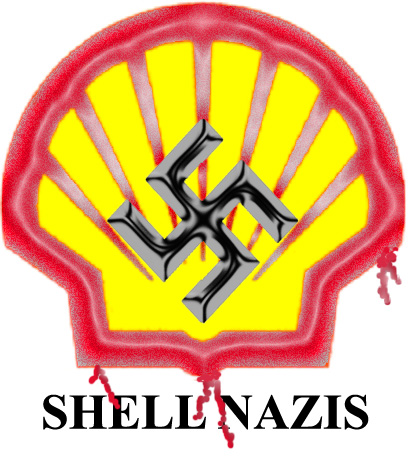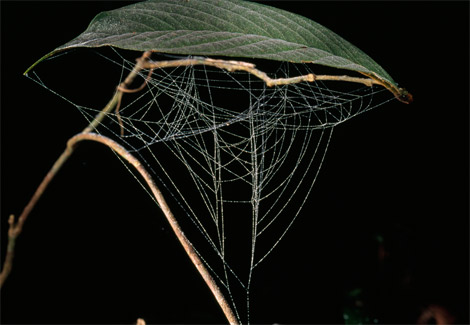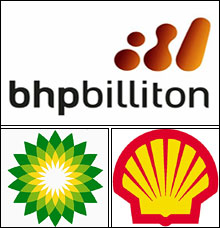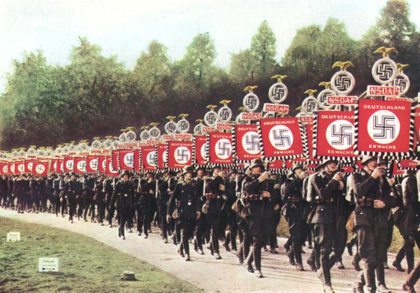Alex Constantine - November 6, 2010
More Royal Dutch Shell Nazi Secrets
RELATIONSHIP BETWEEN ROYAL DUTCH SHELL AND THE NAZIS CONTINUED LONG AFTER THE RETIREMENT OF DETERDING AS CHIEF EXECUTIVE ON 31 DEC 1936
Posted under Fair Use copyright terms
By Alfred Donovan and John Donovan
 The close relationship between Royal Dutch Shell and the Nazis did not end with the retirement of Sir Henri as the most senior executive of the Royal Dutch Shell Group on 31 December 1936. He was a non executive director of several companies within the group from 1 January 1937 until 4 February 1939(1) the day he died.(2)
The close relationship between Royal Dutch Shell and the Nazis did not end with the retirement of Sir Henri as the most senior executive of the Royal Dutch Shell Group on 31 December 1936. He was a non executive director of several companies within the group from 1 January 1937 until 4 February 1939(1) the day he died.(2)
The following is an extract from “A History of Royal Dutch Shell”: Vol 1. Immediately after referring to the funeral of Sir Henri on page 485, it says: -
However, as we have seen above the Group continued to do business with Germany, drawing lube oil supplies, ordering tankers, expanding the Rhenania-Ossag installations, and participating in the Politz works(3)
Rhenania-Ossag was the operating company of Royal Dutch Shell in Germany.(4)
During 1937 and 1938, the lube oil production facility of the Royal Dutch Shell German subsidiary – Rhenania-Ossag – was expanded and modernized.(5) Anglo-Saxon, also part of the Royal Dutch Shell Group, had a total of seven large tankers built at German shipyards between 1935 and 1939, the latest number ordered outside the UK and the Netherlands during those years.(6)
In August 1936, the Nazis announced a Four Year Plan to make Germany independent of foreign gasoline imports. Initially Royal Dutch Shell Group managers refused to allow Rhenania-Ossag to participate in the project, but by February 1937, just weeks after the retirement of Sir Henri as chief executive, the Group reversed the decision.(7)
Royal Dutch Shell invested RM 27.5 million in the related “Politz” project involving partners, Standard Oil of New Jersey and IG Farben.(8)
Extract:
Because the Group wanted at all costs to avoid its commitment to a synthetic gasoline plant becoming public knowledge, two banks fronted as shareholders in Hydrierwerke Politz.(9)
The Politz project, which involved making aircraft gasoline, turned into what has been described as “a devil’s pact”, with soaring costs and construction delays. The Nazi government demanded increased investment. The Royal Dutch Shell Group refused to contribute. In February 1939, the Royal Dutch Shell Group received an ultimatum from the Nazis: if Rhenania-Ossag did not take its full share in the increased costs, the government would take this as an infringement of the company’s duty to act in the interests of the German State, and put the company into administration. Once again Royal Dutch Shell Group managers capitulated and gave Rhenania-Ossag permission to increase its financial commitment to the Politz project, which came on stream in 1940.(10)
In the meantime, in 1938, after the retirement of Deterding as chief executive, Royal Dutch Shell joined a consortium called Catalalytic Research Associates (C.R.A.). The Nazi controlled chemical company IG Farben, was a member of the cartel.(11)
Shell had got into bed with the most notorious and evil company in corporate history, described in the 2008 book “Hell’s Cartel”, as a “war monster”.(12) IG Farben used slave labor, including interment camp prisoners, and held the patent on Zyklon-B gas used during the Holocaust(13 to exterminate millions of people, including children.
Notes
1. Source: Lists of Royal Dutch Shell Executives/Directors pages 93 to 98: “A History of Royal Dutch Shell” Appendices. Figures and Explanations, Collective Bibliography, and Index – aka Vol 4.
2. Information from The Times: “Sir Henri Deterding Obituary” published 6 February 1939.
3. Extract from page 485 “A History of Royal Dutch Shell”: Vol 1: “From Challenger to Joint Industry Leader 1890 -1939” by Joost Jonker & Luiten van Zanden published in the UK in 2007 by Oxford University Press.
4. Information from page 12 “A History of Royal Dutch Shell” Vol 2: “Powering the Hydrocarbon Revolution 1939 -1973″ by Stephen Howarth and Joost Jonker published in the UK in 2007 by Oxford University Press.
5. Information from page 465 “A History of Royal Dutch Shell” Vol 1: “From Challenger to Joint Industry Leader 1890 -1939” by Joost Jonker & Luiten van Zanden published in the UK in 2007 by Oxford University Press.
6. Information from page 467 “A History of Royal Dutch Shell” Vol 1: “From Challenger to Joint Industry Leader 1890 -1939” by Joost Jonker & Luiten van Zanden published in the UK in 2007 by Oxford University Press.
7. Information from page 473 “A History of Royal Dutch Shell” Vol 1: “From Challenger to Joint Industry Leader 1890 -1939” by Joost Jonker & Luiten van Zanden published in the UK in 2007 by Oxford University Press.
8. Information from page 473 “A History of Royal Dutch Shell” Vol 1: “From Challenger to Joint Industry Leader 1890 -1939” by Joost Jonker & Luiten van Zanden published in the UK in 2007 by Oxford University Press.
9. Information from page 473 “A History of Royal Dutch Shell” Vol 1: “From Challenger to Joint Industry Leader 1890 -1939” by Joost Jonker & Luiten van Zanden published in the UK in 2007 by Oxford University Press.
10. Information from page 474 “A History of Royal Dutch Shell” Vol 1: “From Challenger to Joint Industry Leader 1890 -1939” by Joost Jonker & Luiten van Zanden published in the UK in 2007 by Oxford University Press.
11. From page 17, Fluid Catalytic Cracking: Science and Technology: John S. Magee (Author, Editor) Maurice M., Jr. Mitchell (Editor) (Amazon Page).
12. Information from back cover of “Hell’s Cartel: IG Farben and the Making of Hitler’s War Machine” by Diarmuid Jeffreys published in 2008 by Metropolitan Books Henry Holt and Company, LLC.
13. Information from the Wikipedia article: The Holocaust“.
RELATIONSHIP BETWEEN ROYAL DUTCH SHELL AND THE NAZIS CONTINUED LONG AFTER THE RETIREMENT OF DETERDING AS CHIEF EXECUTIVE ON 31 DEC 1936
By Alfred Donovan and John Donovan
The close relationship between Royal Dutch Shell and the Nazis did not end with the retirement of Sir Henri as the most senior executive of the Royal Dutch Shell Group on 31 December 1936. He was a non executive director of several companies within the group from 1 January 1937 until 4 February 1939(1) the day he died.(2)
The following is an extract from “A History of Royal Dutch Shell”: Vol 1. Immediately after referring to the funeral of Sir Henri on page 485, it says: -
However, as we have seen above the Group continued to do business with Germany, drawing lube oil supplies, ordering tankers, expanding the Rhenania-Ossag installations, and participating in the Politz works(3)
Rhenania-Ossag was the operating company of Royal Dutch Shell in Germany.(4)
During 1937 and 1938, the lube oil production facility of the Royal Dutch Shell German subsidiary – Rhenania-Ossag – was expanded and modernized.(5) Anglo-Saxon, also part of the Royal Dutch Shell Group, had a total of seven large tankers built at German shipyards between 1935 and 1939, the latest number ordered outside the UK and the Netherlands during those years.(6)
In August 1936, the Nazis announced a Four Year Plan to make Germany independent of foreign gasoline imports. Initially Royal Dutch Shell Group managers refused to allow Rhenania-Ossag to participate in the project, but by February 1937, just weeks after the retirement of Sir Henri as chief executive, the Group reversed the decision.(7)
Royal Dutch Shell invested RM 27.5 million in the related “Politz” project involving partners, Standard Oil of New Jersey and IG Farben.(8)
Extract:
Because the Group wanted at all costs to avoid its commitment to a synthetic gasoline plant becoming public knowledge, two banks fronted as shareholders in Hydrierwerke Politz.(9)
The Politz project, which involved making aircraft gasoline, turned into what has been described as “a devil’s pact”, with soaring costs and construction delays. The Nazi government demanded increased investment. The Royal Dutch Shell Group refused to contribute. In February 1939, the Royal Dutch Shell Group received an ultimatum from the Nazis: if Rhenania-Ossag did not take its full share in the increased costs, the government would take this as an infringement of the company’s duty to act in the interests of the German State, and put the company into administration. Once again Royal Dutch Shell Group managers capitulated and gave Rhenania-Ossag permission to increase its financial commitment to the Politz project, which came on stream in 1940.(10)
In the meantime, in 1938, after the retirement of Deterding as chief executive, Royal Dutch Shell joined a consortium called Catalalytic Research Associates (C.R.A.). The Nazi controlled chemical company IG Farben, was a member of the cartel.(11)
Shell had got into bed with the most notorious and evil company in corporate history, described in the 2008 book “Hell’s Cartel”, as a “war monster”.(12) IG Farben used slave labor, including interment camp prisoners, and held the patent on Zyklon-B gas used during the Holocaust(13 to exterminate millions of people, including children.
Notes
1. Source: Lists of Royal Dutch Shell Executives/Directors pages 93 to 98: “A History of Royal Dutch Shell” Appendices. Figures and Explanations, Collective Bibliography, and Index – aka Vol 4.
2. Information from The Times: “Sir Henri Deterding Obituary” published 6 February 1939.
3. Extract from page 485 “A History of Royal Dutch Shell”: Vol 1: “From Challenger to Joint Industry Leader 1890 -1939” by Joost Jonker & Luiten van Zanden published in the UK in 2007 by Oxford University Press.
4. Information from page 12 “A History of Royal Dutch Shell” Vol 2: “Powering the Hydrocarbon Revolution 1939 -1973″ by Stephen Howarth and Joost Jonker published in the UK in 2007 by Oxford University Press.
5. Information from page 465 “A History of Royal Dutch Shell” Vol 1: “From Challenger to Joint Industry Leader 1890 -1939” by Joost Jonker & Luiten van Zanden published in the UK in 2007 by Oxford University Press.
6. Information from page 467 “A History of Royal Dutch Shell” Vol 1: “From Challenger to Joint Industry Leader 1890 -1939” by Joost Jonker & Luiten van Zanden published in the UK in 2007 by Oxford University Press.
7. Information from page 473 “A History of Royal Dutch Shell” Vol 1: “From Challenger to Joint Industry Leader 1890 -1939” by Joost Jonker & Luiten van Zanden published in the UK in 2007 by Oxford University Press.
8. Information from page 473 “A History of Royal Dutch Shell” Vol 1: “From Challenger to Joint Industry Leader 1890 -1939” by Joost Jonker & Luiten van Zanden published in the UK in 2007 by Oxford University Press.
9. Information from page 473 “A History of Royal Dutch Shell” Vol 1: “From Challenger to Joint Industry Leader 1890 -1939” by Joost Jonker & Luiten van Zanden published in the UK in 2007 by Oxford University Press.
10. Information from page 474 “A History of Royal Dutch Shell” Vol 1: “From Challenger to Joint Industry Leader 1890 -1939” by Joost Jonker & Luiten van Zanden published in the UK in 2007 by Oxford University Press.
11. From page 17, Fluid Catalytic Cracking: Science and Technology: John S. Magee (Author, Editor) Maurice M., Jr. Mitchell (Editor) (Amazon Page).
12. Information from back cover of “Hell’s Cartel: IG Farben and the Making of Hitler’s War Machine” by Diarmuid Jeffreys published in 2008 by Metropolitan Books Henry Holt and Company, LLC.
13. Information from the Wikipedia article: The Holocaust“.
LINKS TO OTHER PARTS OF ROYAL DUTCH SHELL NAZI SECRETS
Royal Dutch Shell Nazi Secrets: Introduction
Royal Dutch Shell Nazi Secrets Part 1: The Funeral
Royal Dutch Shell Nazi Secrets Part 2: Financier of the Third Reich
Royal Dutch Shell and the Nazis Part 4: Royal Dutch Shell Anti-Semitism
Royal Dutch Shell and the Nazis Part 5: Evidence of Shell/Deterding financial support for the Nazis
Royal Dutch Shell and the Nazi Part 6: I.G. Farben, Royal Dutch Shell and Nazi slave labor
Royal Dutch Shell Nazis Secrets Part 7: Why does it still matter?
Royal Dutch Shell Nazi Secrets Part 8: Nazi connections
Royal Dutch Shell Nazi Secrets Part 9: Further evidence
Royal Dutch Shell Nazi Secrets: Authors relationship with Shell








